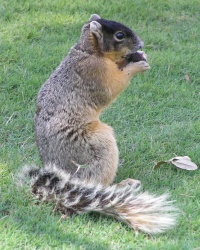 |
|
|
|
 |
|
The Big Cypress Fox Squirrel is a subspecies endemic to the South Florida Ecosystem; averaging 28-38cm. in length and a life span of 7-10 years (Koprowski et al. 1988). Since 1990 it has been listed as threatened by the Florida Fish and Wildlife Conservation Commission, and recently the subspecies was reviewed by the U.S. Fish and Wildlife Service for possible listing as an endangered species. The decline of the Big Cypress fox squirrel mirrors the decline in its preferred habitats as South Florida has been increasingly transformed by human activities. Big Cypress fox squirrels may be present in a variety of habitat types including cypress forest, pine savanna, tropical hardwood forest, oak savanna, mangrove forest, and suburban areas. Its diet consists of cabbage palm fruits, figs, buds, acorns, fungi, bird eggs, nestlings, frogs, slash pine seeds, and cypress seeds. Big Cypress fox squirrels nest in cabbage palm, pine, and cypress trees and depend on cabbage palm trees, fig trees, queen palms, bottlebrush, and silk oaks for food (Jodice and Humphrey 1992). Pelage color is highly diverse ranging from black to buff, with the latter as the most frequent, and tan as the most uncommon (Williams and Humphrey 1979; Humphrey and Jodice 1992). The present distribution of Sciurus niger avicennia is southwestern Florida south of the Caloosahatchee River. Populations are reported to be present in the Big Cypress National Preserve (established in 1974) and the various adjacent pinelands of Collier, Hendry, and northwestern Munroe counties. Due to fire suppression efforts, understory growth in the Big Cypress National Preserve has resulted in less suitable habitat for Big Cypress fox squirrels which require an open, mature, pine-oak forest with minimal understory growth (Jodice and Humphrey 1992).
The purpose of this project is to conduct a status survey to determine the distribution, abundance, and habitat use of Big Cypress fox squirrels (Sciurus niger avicennia). This study will document the historic and current distribution of the BCFS by obtaining and mapping occurrence records from the U.S. Fish and Wildlife Service, Florida Natural Areas Inventory, Florida Museum of Natural History, and other sources, and through interviews with biologists and other field personnel of public land-managing agencies. We will collect information in the form of verified sightings, roadkills (or other dead specimens), and individuals captured in nest boxes or live traps. The U.S. Fish and Wildlife Service will use this information to evaluate the conservation status of the species and to determine whether or not it qualifies for listing under the U.S. Endangered Species Act. . Listing the species under the Endangered Species Act may constrain some activities on private land. However, if the squirrels are relatively abundant on private land, constraints are less likely, and it is less likely that the species will be listed. Therefore, it is in the best interest of landowners, collectively, that many fox squirrels are found on private land.
No accurate estimate of the population size is available, but it is reported that there are no more than a few hundred individuals remaining. Very little research has been done on Big Cypress fox squirrels, only a few scattered populations were ever found. They are present, but rare and highly scattered in Collier, Lee, Hendry, and Munroe counties (Jodice and Humphrey 1992). We will examine the status and distribution of fox squirrels in the Big Cypress National Preserve and suburban habitats such as golf courses, recreational parks, and ranchland to see which habitat characteristics are optimal for the subspecies. Golf courses may provide more suitable habitat for fox squirrels than their native habitat in the Big Cypress National Preserve due to the abundance of native and exotic mast producing species. Big Cypress fox squirrel populations also exist in areas of Hendry and Collier county formerly marshland, pine savanna, and upland prairie that have been drained and converted to pasture. Grazing by cattle hinders understory growth on ranchland and enhances habitat quality for fox squirrels. Previous research has found higher fox squirrel abundance in these types of habitats than in undisturbed habitats.
We hypothesize that the distribution and abundance of Big Cypress fox squirrels is dependent on certain habitat characteristics such as understory height, tree age, and resource availability. We also predict that home range and patterns of dispersal will be associated with habitat connectivity. Finally, we will assess habitat variables in areas that support Big Cypress fox squirrels so that habitat management guidelines can be developed and suitable areas can be protected to ensure the persistence of this rare subspecies.
References
Humphrey, S. R., and P. G. R. Jodice. 1992. Big Cypress fox squirrel. Pp. 224-233 in Rare andEndangered Biota of Florida, vol. 1: Mammals, ed. S. R. Humphrey. Gainesville, University Press of Florida.
Jodice, P. G. R., and S. R. Humphrey. 1992. Activity and diet of an urban population of Big Cypress fox squirrels. Journal of Wildlife Management, 56(4): 685-692.
Williams, Kathleen S. and Stephen R. Humphrey. 1979. Distribution and status of the endangered Big Cypress fox squirrel (Sciurus niger avicennia) in Florida. Florida Scientist, 42(4): 196-200.
|

Big Cypress fox squirrel
|
|
|

|
|

